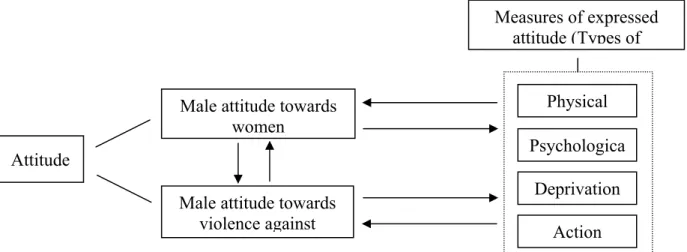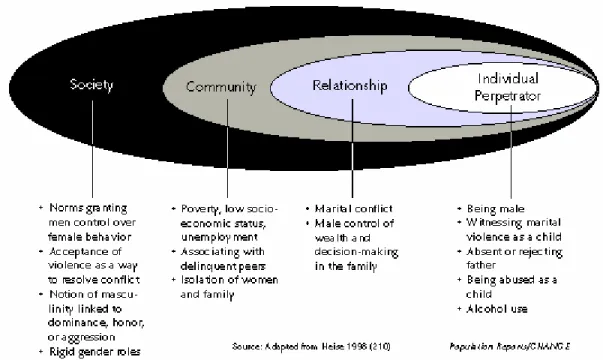There are many women's organizations documenting various forms of violence against women in Bangladesh. The study revolves around two important concepts, viz. men's violence against women and their attitude towards it. Their size definitely testifies to the intensity of the problem regarding men's attitude towards violence against women.
CONTENT
Respondents according to their age, education and food security status 38 Table 5.9: Violence against women considered to be most serious in. 42 Table 6.1: Attitude scores on women in general 44 Table 6.2: Attitude scores on women in general by selected variables 44. 45 Table 6.7: Attitude scores for men to women 46 Table 6.8: Attitude scores for men to women of the selected.
APPENDIX
Later, the husband or other male family members may pressure the wife to pay.
INTRODUCTION
More than one in eight adult women in the United States is raped or sexually assaulted (NVC 1992). Several studies in the eighties and early nineties provided an overall picture of inequality and discrimination against women in Bangladesh. Review research on violence against women, particularly in the context of Bangladesh in light of men's attitudes and behaviour.
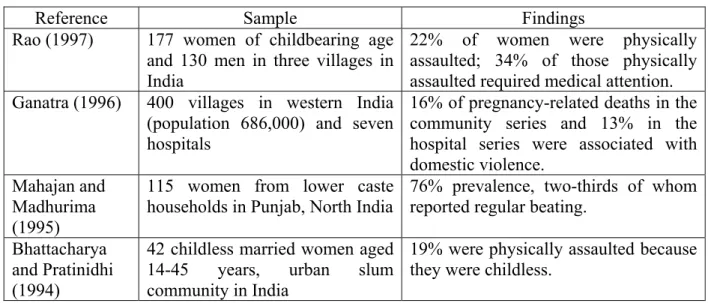
LITERATURE REVIEW
Twenty-six percent of respondents believe that beatings are the most common form of violence against domestic helpers. The personality or attitude of the abuser is generally understood to be the root cause of violence against women. Most of the aggressors (62%) were middle-born, a few (38%) were first-born and none were last-born.
CONCEPTUAL FRAMEWORK
The analyzes in this study were made in terms of typologies related to common and abusive violence and intimate violence in places. The type of violence the perpetrator intends to cause determines the degree of violence. Attitude always includes the individual's relationship to specific situations in his environment.
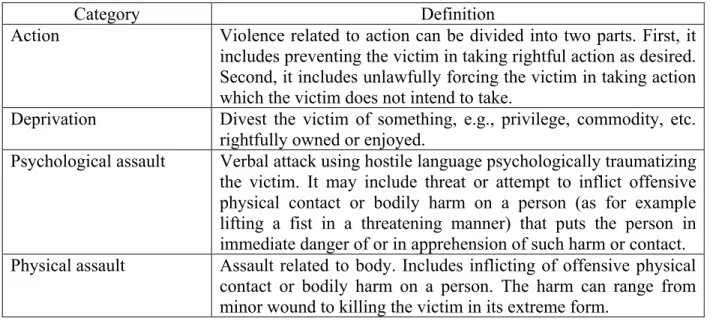
Instrument
The total result from the groups represented the attitude of men towards women and their attitude towards violence against women. Since the man is the head of the family, let him follow his decision. When deciding on family planning, the opinion of both husband and wife should be taken into account.
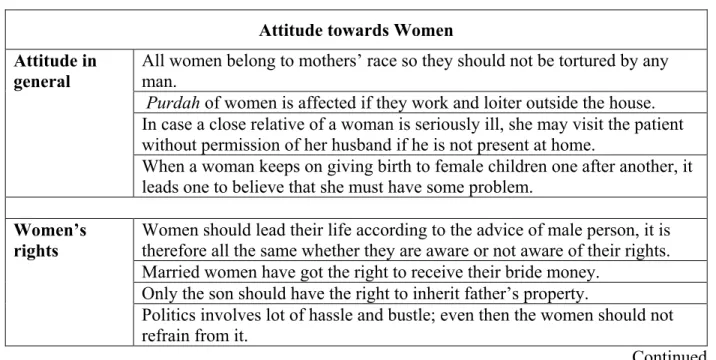
Sampling
Rather, households were interviewed from one end of the village to the other, excluding every third house to ensure that interviewees were evenly distributed throughout the village. Over here the households were also interviewed from one end of the village to the other in the same way as was done in Koyrakanda. The members of the groups were purposively selected with the help of the BRAC area office in Tarakanda.
Problems in Conducting Fieldwork
The case study group included two men and two women to discuss the case with men and women. In case of errors and missing links, we eliminated them, if necessary, by revisiting the interviewees. In the case of case studies, a team member reviews data received from various sources for triangulation and validation.
Analysis Plan
CHAPTER 5
PERCEPTION ON VIOLENCE AGAINST WOMEN
CHAPTER 6
Sixteen percent of respondents were between these two groups, i.e. neither more nor less favorable towards women in general (Table 6.2). The respondents' year of education was significantly related to their attitudes towards women in general. About 54% of respondents had a more favorable attitude towards women's rights compared to about 33% of respondents who had a less favorable attitude (Table 6.3).
About 13% of the respondents were no more or less positive about women's rights (table 6.4). Respondents' education was found to be significantly related to their attitude towards discrimination against women (Table 6.6). Only 5% of the respondents were no more or less positive about psychological violence against women.
Attitude Scale vii About 30% of the respondents had a more favorable attitude towards physical violence against women compared to 32% of the respondent who had a less favorable attitude (Table 6.11). Respondents' participation in NGOs made considerable variation in their attitudes towards violence against women (Table 6.12). A little over 11% of respondents had a neutral attitude towards action-related violence against women.
About 52% of respondents had a more positive attitude towards violence against women compared to about 41% of respondents who had a less positive attitude towards such violence (Table 6.17).
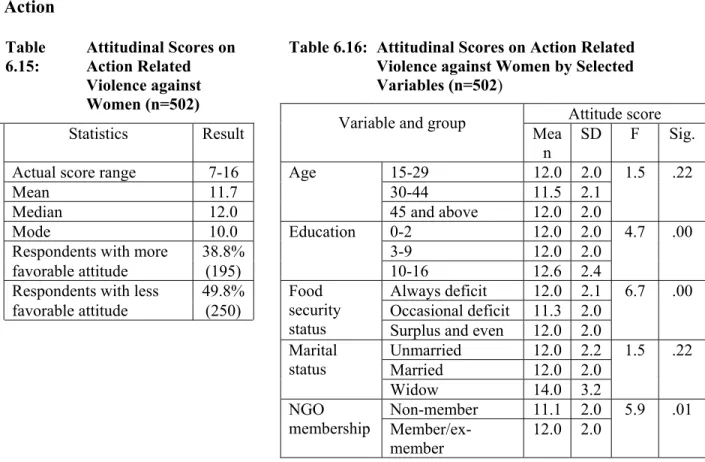
CHAPTER 7
IN-DEPTH ANALYSIS ON ATTITUDE OF MALE
VIOLENCE AGAINST WOMEN
Contrary to these attitudes, some respondents believed that women could be punished for their crime (Box 2). An overwhelming majority of respondents (96%) believed that women had a right to dowry and that the wife should never be deprived of it (Appendix 2.6). The majority of respondents believed that daughters should receive the same amount of food as sons and fathers in the family (Appendix 2.9).
They believed that the man was the head of the family and the family should run according to his will. Where it was believed that the husband was the sole owner of the property, the wife's opinion was not assessed when selling the property. In contrast, when it was believed that property belonging to all members of the family wife's role in decision making was valued.
The respondents saw the statement in relation to the relationship between husband and wife in the family. 92 percent of the respondents believed that the wife should in no way be blamed by the husband for wishes in the family (appendix 2.14). Most of the respondents saw the statement in relation to the decisions that are considered important for the family.
Contrary to the above view, a large number of respondents believed that the husband had the sole right to make decisions for the family. They believed that the son would remain attached to the family and would eventually take charge of the family. In contrast, when property was assumed to belong to all members of the family, the role of women in decision-making was also valued.
CASE STUDIES
Amina's father did not agree to the proposal; the refusal greatly offended Abdul Gafur. After the marriage, Khokon did not bring Hena to his home but left Hena in her mother's house and started living with his first wife in his own house. The tribal society did not accept the marriage, as it was performed at court.
Hena sought justice from the local Muslim elite in the village regarding her rights, but they did not support her. His first wife did not beat Hena as Khokon mentioned that he treated both wives equally. He did not work regularly and used to beat Mina when she objected to his addiction.
When Mina stayed in her father's residence; he did not meet her expenses at times. He had to suffer a lot, although he knew nothing of this occurrence. The statement of Shahid indicated that he did not have a particular stance against rape.
Everyone should be careful so that such an incident did not occur in the town.
Summary
Since Rashida's husband did not stay at home, she stopped leaving the house for any reason at night. Being extremely insecure, Rashida again went to the police station and informed the police about Mannan's activities. Although the police promised her to do so and advised her to go home with a fearless mind, the police did not turn up to arrest Manna.
They also did not object to Mannan's activities, but they mentioned that the reason why Mannan was threatening was because Rashida filed a case against him. They set conditions that Mannan would bear all the costs to withdraw the case from the court and he would never carry out such illegal acts and would not oppress the villagers. To make amends, the perpetrators wanted the victims to behave as they wished.
When there was no need for a relationship, the man did not hesitate to end the relationship and even became violent with them if it was necessary to end it. In the case of rape, the sexual impulse has been shown to be the driving force behind such violence. When carrying out violence, a suitable opportunity was also taken into account, when the perpetrator would be safe in carrying out such violence.
For example, in the case of demanding dowry, the offending husband not only had an attitude that supported the demand for dowry, but also had justification for assaulting wife for it.
CONCLUSION AND RECOMMENDATIONS
Few studies have looked at violence against women in relation to men's attitudes towards it. When taken into account, men's attitudes were found to be one of the determinants of their violence against women. Some of these studies have used feminist theory to explain violence against women in Bangladesh.
It was assumed that the attitude towards women would be positively associated with the score of attitude towards violence against women. It has been noted that denial of women's rights is synonymous with deprivation-related violence and in many cases can lead to action-related violence against women. A good number of these respondents rationalized their position by emphasizing the consequences of violence against women.
One of those important determinants is probably the attitude of male perpetrators towards violence against women. Their magnitude certainly testifies to the intensity of the problem regarding men's attitudes to violence against women. Prevention of violence against women can have different approaches that are addressed at different levels of society.
Through planned psycho-educational and socio-cultural interventions, work can be done to change male objectification of women and their attitude towards violence against women.
Respondents’ attitude on statement, ‘Purdah of women is affected if they work and loiter outside the house.’
Despite this, they are not supposed to scold or beat women in the family.' (n=502). Later, husband or other male members of the family can put pressure on the wife to pay the rest of the dowry.' (n=502).
Reasons for violence against women according to respondents (n=
Respondents’ opinion on selected issues (n= 502)
Steps may be taken to prevent violence against women

